Old Bridge Area of the Old City of Mostar: Mostar is situated in Bosnia and Herzegovina, about 40 km from the border between Croatia and Bosnia and Herzegovina. Mostar is renowned for the Old Bridge, the iconic Stari Most, after which the city is named. The Old Bridge of Mostar spans the Neretva River. The Old Bridge was built in 1557-1566 during the Ottoman Empire, the bridge was on completion the widest man-made arch in the world. The bridge was completely destroyed during the Bosnian War (1992-1995). After the war, the Old Bridge of Mostar was reconstructed with stones from the same quarry that supplied the original stones in the 16th century and using 16th century building techniques. The reconstruction was completed in 2004. The Stari Most is the symbol of the city of Mostar. The Crooked Bridge, built around 1558, is situated near the Old Bridge of Mostar. In December 1999, the Crooked Bridge (Kriva Cuprija) collapsed during winter floods, but mainly because of the damage inflicted during the war. The reconstruction of the bridge was finished in 2001. The Tabacica Mosque, built around 1600, and the 17th century Koski Mehmed Pasha Mosque suffered severe damage during the Bosnian War(1992-1995). After the war, both the mosques were restored. The Old City of Mostar is also well-known for its historic Turkish houses, built during the Ottoman period. The Old Bridge Area of the Old City of Mostar became a UNESCO World Heritage in 2005.
www.werelderfgoedfotos.nl © Copyright World Heritage Photos
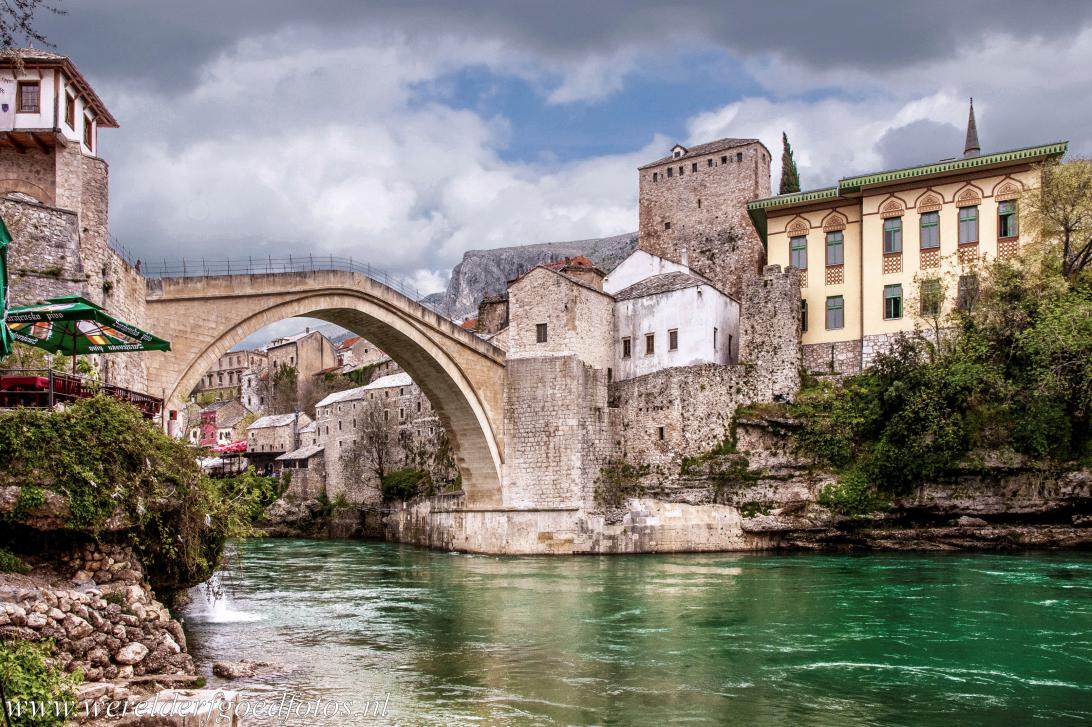
Old Bridge Area of the Old City of Mostar: The green tinted waters of the Neretva flows beneath the Old Bridge of Mostar, the Stari Most. The bridge was originally built in 1557-1566, during the Ottoman period. The single-arched stone bridge is a fine example of the Ottoman architecture. The Stari Most was on completion the widest man-made stone arch in the world. The Old Bridge Area of the Old City of Mostar was declared a UNESCO World Heritage in 2005.

Old Bridge Area of the Old City of Mostar: The green tinted waters of the Neretva flows beneath the Old Bridge of Mostar, the Stari Most. The bridge was originally built in 1557-1566, during the Ottoman period. The single-arched stone bridge is a fine example of the Ottoman architecture. The Stari Most was on completion the widest man-made stone arch in the world. The Old Bridge Area of the Old City of Mostar was declared a UNESCO World Heritage in 2005.
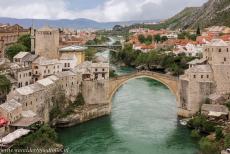
Old Bridge Area of the Old City of Mostar: The Old Bridge and its two fortified towers, called the Mostari. The Old Bridge of Mostar, the Stari Most, spans the Neretva, the amazing green tinted water of the Neretva flows through the centre of Mostar. The Stari Most was destroyed during the Bosnian War (1992-1995), the reconstruction costed nearly €13 million. The Stari Most is the symbol of Mostar and now also the symbol of the unification of the once so divided country.
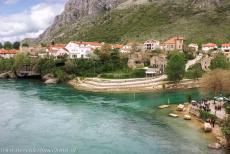
Old Bridge Area of the Old City of Mostar: The remains of the destroyed Stari Most are still on the banks of the Neretva River. During the Bosnian War, the original 16th century Stari Most, the Old Bridge of Mostar, was totally destroyed in 1993. After the war, the bridge was reconstructed with 16th century materials and building methods. The reconstruction of the historic bridge was completed in 2004. The remains of the old Stari Most are now silent witnesses to the war.
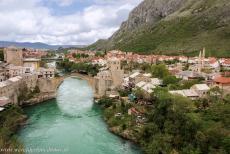
Old Bridge Area of the Old City of Mostar: The Stari Most is one of the symbols of Mostar. After the war (1992-1995), the Old Bridge became a symbol of hope and healing. It is a traditional for young men to jump from the bridge into the Neretva, a risky sport, due to the shallow waters of the Neretva River. The tradition dates back to the time of the constuction of the bridge. The first recorded jump took place in 1664. A cliff diving competition is held every summer since 1968.
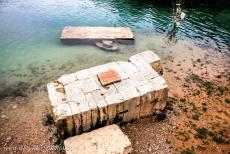
Old Bridge Area of the Old City of Mostar: The remains of the ancient Stari Most on the banks of the Neretva River, the coldest river in the world. Nowadays, the remains of the Stari Most are a memorial monument. Other remaining parts of the Stari Most can be found in a small park in the historic centre of the city of Mostar. The Stari Most is the Old Bridge of Mostar. The bridge is the most important monument of the Old City of Mostar and also a UNESCO World Heritage.
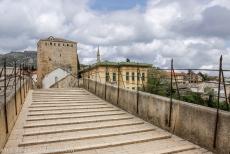
Old Bridge Area of the Old City of Mostar: The Mostari Gates, the Helebija Tower and the Tara Tower, are the entrances to the Stari Most, the Old Bridge of Mostar. The Stari Most only carries pedestrians. The Tara tower houses nowadays a museum dedicated to the history of the bridge. Archduke Franz Ferdinand of Austria and his wife Sophie visited the bridge during their visit to Mostar, just a few days before they were assassinated in Sarajevo.
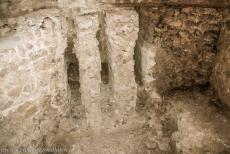
Old Bridge Area of the Old City of Mostar: During the guided city tour, the city guide showed us the important historic sights of Mostar, he also showed us the original 16th century foundations of the Old Bridge of Mostar, the Stari Most. The foundations are situated beneath the Mostari, the fortified towers that guard either end of the bridge. The Stari Most was destroyed during the Bosnian War, but the foundations of the bridge remained largely intact.
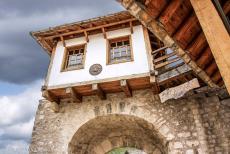
Old Bridge Area of the Old City of Mostar: The Mostari are two fortified towers, a tower on each side of the Old Bridge. The Mostari were built to protect the Stari Most, the Old Bridge. The Tara Tower was built in 1676, more than a century after the Stari Most, the tower houses nowadays the Old Bridge Museum, the 17th century Helebija Tower was used as a storehouse for weapons and gunpowder, the tower is nowadays used by the Mostar Diving Club.
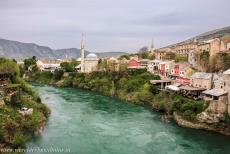
Old Bridge Area of the Old City of Mostar: The Koski Mehmed Pasha Mosque was built around 1617, it stands on the banks of the Neretva River. The small Tabacica Mosque was built around 1600 and also situated in the Old City of Mostar. The Tabacica Mosque and the Koski Mehmed Pasha Mosque suffered severe damage during the Bosnian War (1992-1995). After the war, the mosques were restored. The Koski Mehmed Pasha is the second largest mosque in Mostar.
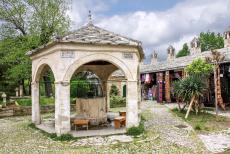
Old Bridge Area of the Old City of Mostar: The šadrvan is a fountain in the courtyard of the Koski Mehmed Pasha Mosque, the most renowned mosque in the centre of Mostar. A šadrvan is used by Muslims to wash their hands, face and feet before entering the mosque to pray. The idea of building šadrvans comes from the Persian culture and was brought to Bosnia and Herzegovina during the Ottoman period.
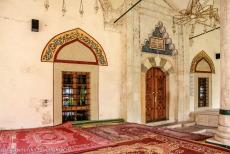
Old Bridge Area of the Old City of Mostar: The entrance into the Koski Mehmed Pasha Mosque. The most important element in the mosque is the mihrab, a niche in the wall that indicates the direction of Mecca. The mosque is worth a vist, it is also allowed to climb the minaret, it offers breathtaking views over the Old Bridge Area of the Old City of Mostar. The mosque is situated on the banks of the Neretva River, nearby the Old Bridge of Mostar.
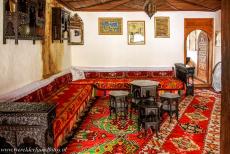
Old Bridge Area of the Old City of Mostar: Living room in the Biščevića Kuća, one of the historic Turkish houses in Mostar, it is one of the finest preserved houses in Mostar from the Ottoman period. The Turkish house is situated on the left bank of the Neretva River, it is still furnished in the traditional Turkish style, such as carved wooden furniture and colourful Turkish tapestries. The Turkish houses in Mostar are beautiful examples of Ottoman architecture.
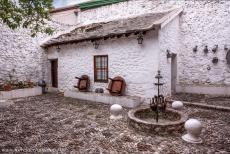
Old Bridge Area of the Old City of Mostar: The fountain in the courtyard of the Biščevića Kuća, one of the historic Turkish houses in Mostar. The historic Turkish house was built in 1635, the courtyard is a beauriful example of the Ottoman style. The Old City of Mostar is not only known for the Stari Most, but also renowned for its historic Turkish houses, which were built in the 15th and 16th centuries when Mostar was an Ottoman border town.
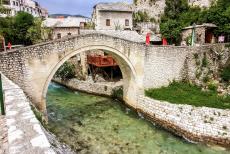
Old Bridge Area of the Old City of Mostar: The Crooked Bridge (Kriva Cuprija) is a tiny stone arch bridge and looks like a miniature version of the Old Bridge of Mostar, the bridge was built close to the Old Bridge around 1558. The Crooked Bridge is crossing the Radobolja, this creek flows into the Neretva River nearby the Old Bridge. The Crooked Bridge collapsed in December 1999 during winter floods but mainly because of the damage inflicted during the Bosnian War (1992-1995). In 2001, the bridge was reconstructed with 16th century materials and building methods. The reconstruction was financed by the Grand Duchy of Luxembourg.
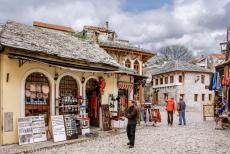
The Tepa Market in the Old Bridge Area of the Old City of Mostar, the streets in the historic city of Mostar are paved with cobblestones, along the streets are numerous souvenir shops. Mostar was founded in the 13th century. The city of Mostar is known for its Old Bridge (Stari Most) after which the city is named. The town is a popular destination for tourists, especcially the Stari Most and the old bridge area attract many visitors from all over the world.
